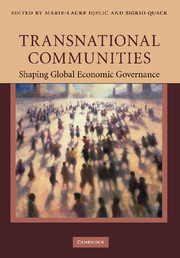Book contents
- Frontmatter
- Contents
- List of figures
- List of tables
- List of appendices
- Contributors
- Preface
- Part I Introduction
- Part II Classical communities with a transnational extension
- Part III Professional communities with a transnational extension
- Part IV Virtual communities
- 9 Gift-giving, transnational communities, and skill-building in developing countries: the case of free/open source software
- 10 Epistemic communities and social movements: transnational dynamics in the case of Creative Commons
- Part V Transnational interest- or issue-based communities
- Part VI Conclusion
- Index
- References
10 - Epistemic communities and social movements: transnational dynamics in the case of Creative Commons
Published online by Cambridge University Press: 07 September 2010
- Frontmatter
- Contents
- List of figures
- List of tables
- List of appendices
- Contributors
- Preface
- Part I Introduction
- Part II Classical communities with a transnational extension
- Part III Professional communities with a transnational extension
- Part IV Virtual communities
- 9 Gift-giving, transnational communities, and skill-building in developing countries: the case of free/open source software
- 10 Epistemic communities and social movements: transnational dynamics in the case of Creative Commons
- Part V Transnational interest- or issue-based communities
- Part VI Conclusion
- Index
- References
Summary
Is it impossible to imagine the lawyers ever on the side of innovation?
Lawrence Lessig (2003)Introduction
When Victor Hugo in 1878, with an inaugural address at the Paris World exhibition, helped to initiate the Berne Convention for the Protection of Literary and Artistic Works (inured in 1887), he could hardly have imagined that, 120 years later, law professors, artists, and software producers would mobilize worldwide against the successor of the Berne Convention in favor of the free use of intellectual products such as texts, music, and software. The most recent and most obvious expression of this movement is the foundation of “Creative Commons” as a US-based non-profit organization in 2001, which has since extended its operation to over fifty different national jurisdictions. The aim of Creative Commons, according to its statutes, is to build a layer of “reasonable, flexible copyright” into the existing restrictive copyright law. Creative Commons develops licenses that enable people to dedicate their creative works to the public domain – or retain their copyright while licensing them as free for certain uses, on certain conditions.
The organization “Creative Commons,” however, is only the most visible part of a wider transnational community that supports ideas of “free use” and “share alike” in the field of free and open source software (for example, the Free Software Foundation), artistic production, information (for example, the Wikimedia Foundation), and science (for example, diverse open access initiatives1).
- Type
- Chapter
- Information
- Transnational CommunitiesShaping Global Economic Governance, pp. 226 - 252Publisher: Cambridge University PressPrint publication year: 2010
References
- 11
- Cited by



